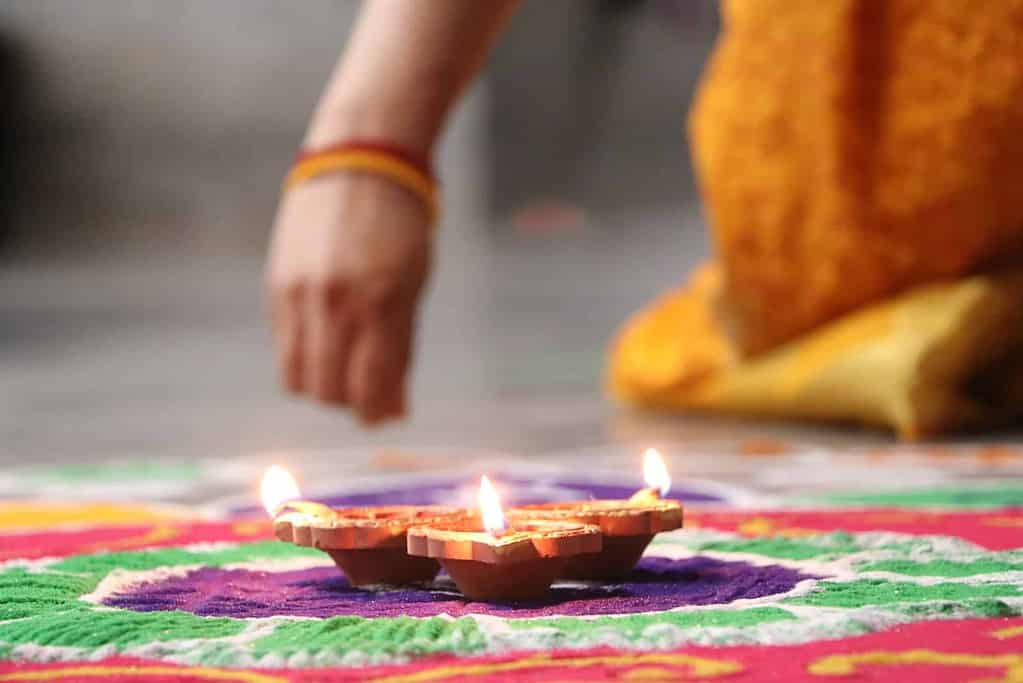Patanjali Yoga: Our Comprehensive Guide To The Yoga Sutras & The Eight Limbs
The post Patanjali Yoga: Our Comprehensive Guide To The Yoga Sutras & The Eight Limbs appeared first on The Yoga Nomads.

Have you recently heard of Patanjali?
Patanjali is the grandfather of yoga, and the yoga sutras of Patanjali are like the bible of yoga! Thus, every avid yogi wanting to learn where the practice comes from and what it truly means should read the yoga sutras.
By reading the yoga sutras, you’ll discover that the yoga we practice today significantly differs from the traditional form.
But what are the key differences, and should we seek to return to yoga’s roots?
This comprehensive guide to Patanjali yoga sutras will uncover multiple aspects of the yoga tradition. We’ll then decipher Patanjali’s teachings to understand how we can use this ancient wisdom in our modern-day practice.
So make a cup of tea, get cozy, and let’s dive in.
Who Was Patanjali?
Patanjali, also known as Gonardiya or Gonikaputra, was an Indian sage believed to be the author of the most prominent yogic scripture, the yoga sutras.
While the yoga sutras have been translated from their original Sanskrit language (the ancient language of Hinduism), little is known about Patanjali himself. However, he is often seen as a divine (godly) figure in Hinduism, and it is believed he lived for a very long time, over 1000 years.
Various Hindu texts speak of Patanjali as a divine figure, such as Vishnudharmottara Purana from the 6th century BC.
Patanjali’s Yoga Sutras

The yoga sutras of Patanjali were believed to have been written sometime between the second century BC and the fifth century CE. The comprehensive ancient text contains 196 Sutras, divided into four chapters. Interestingly, each sutra is just a short sentence, yet each one holds a powerful teaching waiting to be unpacked.
The Sanskrit word Sutra literally translates to ‘aphorism,’ which means teachings from spiritual masters. However, a better English translation of sutra is “thread,” as each of the sutras is a thread of knowledge, which, when connected, can help you uncover your true nature and attain liberation.
Several spiritual teachers and scholars have translated the yoga sutras of Patanjali. Still, one of the most well-known is Sri Swami Satchidananda, who wrote the book “Yoga Sutras of Patanjali.”
Sri Swami Satchidananda is a prominent figure in the yoga world. He was one of the first yogic masters to bring the classical yoga tradition of asana and meditation to the western world, starting when he was first invited to America in 1966.
You can also find translations of the original Sanskrit scripture online. For example, Hindu Sannyasin monk Satguru Bodhinatha Veylanswami interprets the yoga sutras on Himalayan Academy.
Most scholars give commentary on each sutra as the true meaning of the yoga sutras is difficult to translate into another language.
Let’s look at each of the four chapters of the yoga sutras of Patanjali in more detail.
Chapter 1
The first chapter is about contemplation and meditation. It starts by explaining what yoga is and its ultimate goal. Patanjali then describes the five types of ‘Vritties” (mental conditions), which are:
Correct knowledge (Pramana) Incorrect knowledge (Viparyaya) Imagination or fantasy (Vikalpa) Sleep (Nidra) Memory (smrti)Patanjali then goes deeper into how to attain Samadhi (the goal of yoga). He talks about different paths to gaining control of the mind, such as chanting mantras (sutra 1.28).
He also explains the different types of Samadhi and how past yogis obtained enlightenment. Moreover, in sutra 1.30, he discusses the common distractions/obstacles that can arise during yoga practice, including sickness, apathy, doubt, carelessness, laziness, sensual indulgence, and false perspective. He stresses that these must be overcome to attain self-realization.
Next up, in sutra 1.32, Patanjali explains that to overcome these distractions, you should practice concentrating on a single subject (tat pratiṣedhārtham eka tattvābhyāsaḥ). He further explains the ways we can raise our consciousness, including by projecting friendliness and compassion to the people we interact with.
It is yoga sutra 1.34, where Patanjali first talks about pranayama (breath control), saying that regulation of the breath helps us quiet the mind (pracchardana vidhāranābhyāṃ vā prāṇasya).
Chapter 2
The second chapter of the yoga sutras of Patanjali is about sadhana, which means “effective means of attainment.”
Patanjali uses this chapter to share tools and techniques to attain Samadhi and explains the practice of Raja yoga. This is also when the eight limbs of yoga are described, but only the first five limbs are explained in detail in this chapter.
Patanjali begins chapter two by speaking about Kriya yoga. In the yoga sutras, this relates to religious action, not the common breathing technique known as kriya yoga today. In sutra 2.3, Patanjali states that kriya yoga can reduce the five kleshas; ignorance, I-am-ness, attraction, aversion, and clinging to life (avidyāsmitārāgadveṣābhiniveśāḥ kleśāḥ).
He then talks about karma, explaining that kleshas are the root source of our stored karma. Later, in sutra 2.13, Patanjali explains that our karma determines our birth status, life span, and life experiences (sati mūle tadvipāko jātyāyurbhogāḥ).
In yoga sutra 2.28, Patanjali first mentions the eight limbs of yoga (which I’ll describe in more detail later, don’t worry!) He states that when you practice all the limbs of yoga, three things happen:
Your impurities are destroyed You gain radiant knowledge and wisdom You can separate yourself from your mind and distinguish between the observer and the doer (the seer and the seen)
Chapter 3
The third chapter details the final three limbs – Dharana (concentration), Dhyana (meditation), and Samadhi (self-realization). It is also about the properties and powers we can gain from advanced yoga practice.
Patanjali explains that the first five Yamas are the external foundational practices, while the final three are the internal practices. He says the three last limbs together are Samyama, which means they all naturally progress.
You start with Dharana, concentrating on a single object, eventually leading to Dhyana (meditation), which will finally lead to Samadhi.
Yoga sutra 3.5 (tajjayātprajñālokaḥ) states that mastering Samyama results in a flashing-forth of mystical insight. The Sanskrit word for mystical insight is Prajna, which refers to the wisdom obtained from the state of Samadhi.
Sutra 3.18 gives an interesting insight into karma and past lives. It teaches that all our past actions from this life and our past ones leave an impression, known as Samskara, on our minds.
When we practice Samyama, the last three limbs, the actions which created them become apparent. With advanced yoga practice, we may gain insight into our past lives.
The next yoga sutra is just as thought-provoking as it suggests we can obtain knowledge of another person’s mind, such as their current mental state if we make them our object of Samyama.
The chapter then goes on to say that we can absorb human virtues or the positive qualities of animals by focusing our concentration on them through Samyama. For example, we can acquire friendliness from a friendly person or strength from an elephant. This specific and advanced form of Samyama involves focusing your inner light toward an external object.
It then goes deeper, explaining how Samyama can help us attain and access other things like knowledge of our body’s constitution or a deeper understanding of the function of the sense organs.
Chapter 4
The fourth chapter is about freedom/liberation, called Kaivalya/Moksha in the sutras. This final part of the yoga sutras of Patanjali states that there are five possible ways to attain physic or paranormal powers, though they are not described in detail.
By birth With herbs Mantra chanting Practicing Austerity The practice of Yoga (Samadhi)By birth means someone who is born with these powers because of practice in their previous lives. This person will be without any stored karma, as they would have eliminated it in their past lives.
The Definition Of Yoga According To Patanjali

The most common definition you find of yoga nowadays is “union.” This comes from the literal translation of the Sanskrit word yoga, which means “to yoke.” Thus, yoga is a practice to unite the body, mind, and soul.
While, in my opinion, this is not an incorrect definition, you may wonder if this is the definition Patanjali gave.
Patanjali begins the first chapter by giving a definition of yoga. Yoga sutra 1.2 is “Yogaha chitta vritti nirodhah”
Let’s break this yoga sutra down to understand its meaning:
Chitta means mind, Vritti means modifications of the mind Nirodhah means to controlPutting these words together, yoga means ‘to control the fluctuations of the mind.’
This relates to the busyness of our minds, always jumping from one thought to another, from the past to the future, rarely staying in the present moment. Patanjali suggests that you will learn to control your mental activity through yoga practice.
In fact, the following yoga sutra adds to this – “Tada drashtuh swarupe awasthanam”, which translates as “after gaining control of the mind, the seer establishes himself into the true state of being.” This means you discover your true essential nature when you learn to control your mind through yoga.
The Eight Limbs Of Yoga According To Patanjali
The most studied and well-known part of Patanjali yoga sutras is the eight limbs of yoga, also called the eightfold path. This is where Ashtanga yoga got its name, as it literally means “eight limbs” in Sanskrit (Ashta = eight, and Anga = limb).
The eight limbs are meant to be followed in order, and Patanjali often stated in the sutras that you cannot master a limb until you have mastered the ones below it.
Let’s take a look at each of the eight limbs.
Yamas (moral codes or disciplines)

The first limb, Yama, translates to “restraint. Thus, the Yamas are “ethical restraints” or guidelines of how we should act in the world.
Being the first limb, the Yamas are the necessary foundation of a yoga practice. Thus, Patanjali’s yoga sutras show us that our behaviors and actions (how we act in daily life) are a more significant aspect of yoga than the postures we put our bodies into.
Without practicing the Yamas, you can make no sustainable progress in your spiritual journey, regardless of how many yoga postures you can master! Moreover, practicing the Yamas will help you experience harmonious relationships with others and the universe.
There are five Yamas:
Ahimsa (non-harming)
Ahimsa is best translated as non-harming and non-violence, but this teaching goes much deeper than not going around hurting anyone physically. Instead, Ahimsa covers all the ways we can cause harm to others, such as through our words, actions, and even thoughts.
There are many ways we can unintentionally cause harm, such as cursing someone who cut us off in traffic, thinking judgemental thoughts about a co-worker, or complaining about our boss.
Why is this important?
Because responding with harmful thoughts, actions, or words may result in bad karma. We seek to eliminate our negative karma through traditional yoga, not add to it.
Moreover, Ahimsa extends beyond human beings, involving the whole world. Thus, Ahimsa doesn’t only teach us to treat other people well, but it guides us to treat animals and nature with loving kindness too.
Lastly, this Yama also means we should not practice non-violence towards ourselves.
Again I’m not talking about physical self-harming here (although it does include that too). However, I’m referring to the many ways we cause harm to ourselves by thinking negatively or talking badly about ourselves.
So to live this Yama, we must focus on being nice to ourselves and others. One practice is to catch whenever we say or think something negative about ourselves and replace it with self-love.
Satya (truthfulness)
Satya translates to truthfulness. However, like all the Yamas, Satya is much more than refraining from telling lies. ‘Sat’ literally translates as ‘true essence ‘or ‘true nature’ and is also associated with the term ‘unchangeable.’
This term refers to how we see certain things, like our beliefs, to be absolute and unchangeable.
Our thoughts, emotions, and moods form our beliefs, yet these things change frequently. Therefore, our beliefs cannot be absolute. Yoga practice and self-reflection are vital in helping us see new perspectives.
Of course, Satya is also about being honest with ourselves, such as admitting mistakes, owning our weaknesses, and not ignoring our problems by pretending everything is ok. Satya teaches us that to be truthful to others, we must first be honest with ourselves.
Asteya (non-stealing)
Asteya translates to non-stealing and relates to how we can steal from others and ourselves. Aside from stealing physical possessions, we often steal from the environment when we don’t treat the planet with the love it deserves.
Unfortunately, it has become human nature to see ourselves as superior to the planet, even though we would not be here if it wasn’t for the oxygen and water the earth creates!
So when humankind collectively destroys the earth by cutting down rainforests, polluting the oceans, and burning fossil fuels, we take more from the planet than we give back.
Ironically, by stealing from the earth in this way, we are also stealing from ourselves, as once we destroy the planet, we will no longer exist.
We must also ensure we are not stealing from ourselves. We can steal opportunities and happiness from ourselves through self-sabotaging behaviors, which are often the result of self-deprecating thoughts.
For example, if we have low self-worth, we tell ourselves we are not good enough for a particular job, relationship, or opportunity. Thus, we literally steal our dream life from ourselves.
Brahmacharya (abstinence)
Brahmacharya is the Yama that is hardest to unravel. As it is commonly translated as celibacy, most yogis dismiss it as irrelevant in modern-day life. However, when you study it further, you will find a very relevant modernized teaching.
The most accurate translation of Brahmacharya is ‘behavior which leads to Brahman.’ Brahman is seen as ‘the creator’ and a higher power in Hinduism. Thus, this Yama traditionally means if you use your energy/power (including sexual energy) in the right way, you will become closer to God.
However, you don’t have to believe in Brahman to practice this Yama. Instead, you can see Brahmacharya as directing your energy away from external desires and temptations that harm your physical and mental health.
In this sense, Brahmacharya relates to freeing ourselves from addictions, whether it’s to sex, gambling, drinking, or drugs. It can also refer to the self-destructive behaviors we do that harm ourselves, such as binge eating.
When we look at Brahmacharya in this sense, we see it as using your energy correctly to become closer to ourselves, our personal God.
Aparigraha (non-hoarding)
Aparigraha means non-greed and non-possessiveness, which relates to several things, such as not hoarding material possessions, not trying to control others and not becoming too emotionally attached to people.
Traditionally, yogis might have renounced all their possessions to practice this Yama, but there are many other ways you can practice it. For example, Aparigraha teaches us to take just what we need rather than be greedy. This means not ordering more food than we can eat or not buying more clothes than we need.
Hoarding and greed stem from a scarcity mindset where we believe there is not enough for everyone or that resources will run out, so we should take as much as we can. Through yoga practice, we learn to think from an abundance mindset instead and let go of our attachments to material possessions and people.
Niyamas (personal observances)

While the Yamas teach us how to act in the world and treat others to attain pure consciousness, the second limb, Niyamas, relates to how we behave towards ourselves.
The Yamas and Niyamas combined are guidelines for living a purposeful life and preparing for more advanced practices such as meditative absorption.
There are five Niyamas:
Saucha (cleanliness)
Saucha means purification or cleanliness, but of course, it is not just talking about personal hygiene. Instead, Patanjali’s yoga sutras teach that your mind should be clean, as in no negative, harmful thoughts.
This Niyama is closely linked to Ahimsa, as to practice Saucha, you should practice having pure and positive thoughts about yourself and others. When you increase your self-awareness through meditation, it becomes easier to notice when you are thinking something that is not pure or positive.
Saucha can also relate to eating nutritious food to keep your inner workings clean. Moreover, it relates to maintaining a clean, tidy home and work environment, as clutter and dirt can interfere with the mind.
In yogic traditions, there are many cleansing techniques that yogis would follow, such as Neti (Nasal Cleansing), Kapalbathi (Sinus Cleansing), and Nauli (Abdominal Massaging). These techniques are all a practice of Saucha.
Santosha (contentment)
Santosha refers to contentment, a feeling many of us are constantly searching for. Sutra 2.42 (saṃtoṣādanuttamasukhalābhaḥ) translates as “through contentment unsurpassed joy is gained.”
Santosha is not about having contentment or happiness as an end goal you are always working towards. In yogic teachings, it is not the result of achieving our goals. Instead, Patanjali’s yoga sutras teach that we should practice feeling happiness and joy in the present moment.
Santosha is about being content with how your life is right now. It is about gratitude for the present moment rather than wishing and willing future events to occur that we believe will bring happiness.
Santosha is also about creating contentment inside ourselves rather than seeking it in the external world. When we let go of our expectations for our partners, children, or job to make us happy, we turn our attention inwards, the only place where we can truly find happiness.
Happiness is a choice. To feel Santosha, we must let go of the past and our longing for the future. Through yoga, we learn to live more in the present moment, and as a result, we feel contentment.
Tapas (Self-Discipline)
The literal translation of Tapas is “heat,” but it is best described as self-discipline or self-control (no, unfortunately, this is not where the yummy Spanish cuisine comes from!)
Tapas refers to the heat that builds during periods of determined effort, physically, mentally, or spiritually. It highlights the importance of disciplining ourselves to do something we don’t want to do because we know it will improve our lives.
A modern-day example of this is going to the gym. Many of us don’t particularly enjoy working out, but we know it is good for us, so we discipline ourselves to go. With each workout, we build more heat/tapas, and eventually, we don’t need to discipline ourselves; we just do it.
Thus, the best way to view tapas is as the practice of making healthy changes. This could be controlling how much sugar we consume, how much alcohol we eat, or how much Netflix we watch.
Tapas is the energy that helps us stay disciplined, and the more we practice it, the stronger that energy becomes.
Svadhyaya (self-Study/Self-knowledge)
The literal translation of Svadhyana is “to recollect the self.” It means reflecting on or studying ourselves. It relates to our spiritual growth and the practice of all the limbs of yoga that allows us to discover our true selves.
Svadhyaya is an internal study rather than studying outside forces. Even so, certain external studies like reading yogic scriptures can help us gain more self-realization.
Self-reflection allows us to discover so much about ourselves. When we review our past actions, we find out our flaws and weaknesses and understand what we need to work on to progress in our spiritual journey.
Ishvara Pranidhana (devotion)
Ishvara Pranidhana means devotion and self-surrender. It is about dedicating our practice to a higher power and the understanding that there is something greater than the self.
It is not about mindlessly submitting to another’s will. Instead, it is about putting your faith into whatever higher power you believe in, trusting that they guide you towards your dharma. When we do this, we let go of our constant need and desire to control everything, which is a very freeing feeling.
Patanjali teaches that to reach the goal of yoga, we must detach from our egoic self and personal identity. Instead, whenever we practice yoga, our purpose should be deepening our connection to the universe, which deepens our relationship with our true selves.
Asanas (physical postures)

Asana is the one limb that most modern yogis know and practice. But two things are very interesting about the teachings of asana in the yoga sutras of Patanjali.
Firstly, it is the third limb, coming after the Yamas and Niyamas. This suggests that traditionally asana is not the fundamental part of the practice as modern yoga teaches.
Secondly, while asana relates to yoga postures, in the yoga sutras, you won’t find a long list of the many modern yoga poses.
Instead, Patanjali describes asana as a meditation posture and explains the importance of a comfortable seated position to experience a deep meditation experience where you witness consciousness of the soul.
In classical yoga, asana’s purpose is to strengthen the body and make it more flexible so that you can find more comfort while meditating.
Patanjali teaches that asana should be done in a relaxed state with ease and joy rather than pushing and pulling your body past its limitations. It also helps to improve your posture, which prepares you for the next limb – pranayama, which means breath control.
Pranayama (breathing techniques)
In the yoga sutras, pranayama is explained as regulating inhalation and exhalation and creating a space between each. For example, Sutra 2.51 explains that controlling the breath allows you to reach a stage where the breath remains regulated without conscious effort.
The sutras also state that pranayama helps regulate the flow of prana (life force) and increase mental concentration for the sixth limb – Dharana.
While Patanjali talks about the importance of slowing and restraining the breath, he doesn’t detail a specific breathing technique. However, breathing techniques like Nadi Shodhana (alternative nostril breathing) have been described in later yogic books like the Hatha Yoga Pradipika, written in the 15th century.
Pratyahara (sense withdrawal)
Before reaching Dharana (concentration), you must first learn to withdraw your senses, which is what Pratyahara is. Through Pratyahara, we close down the senses, just like we do before we fall asleep – but the difference is in Pratyahara, we remain conscious.
Pratyahara is believed to be the beginning of the journey inwards. Ancient yogis taught that the senses are responsible for the distractions preventing us from getting in touch with our own nature.
The Bhagavad Gita, an ancient Hindu scripture, describes our senses like a boat on the water. Each time the five senses are charmed by external objects, the ship is swayed by the turbulent waves of sense perception.
Practicing sense withdrawal is something we could greatly benefit from in this modern world full of external distractions. Whenever we consume news or media, we move further and further away from our true nature.
One last note Patanjali makes on pratyahara in the yoga sutras is that along with closing down the senses, practicing this limb allows us to control them. For example, Sutra 2.55 (tataḥ paramā vaśyatendriyāṇām) translates to “this results in supreme self-control over the sense organs.”
Dharana (concentration)

Dharana means to concentrate all your attention on one single object. It prepares you for the next limb, a deep meditative state. To practice Dharana, you can focus on any unmoving object, such as a candle, like in Trataka meditation.
Dharana is an excellent way to train our minds in modern life. By practicing it regularly, we don’t just cultivate concentration in meditation but also in daily life. Dharana helps us become immune to external distractions and maintain our focus on the one thing we are doing, whether it’s a work task, washing the dishes, or having a conversation with someone.
Dhyana (meditation)
Dyana is what we know as meditation, but in the sutras, it is described as the uninterrupted flow of concentration. It is a natural occurrence from practicing Dharana as once you have concentrated on an object long enough, you become one with it. At this point, you experience a union, becoming absorbed in it.
It’s important to note that Dhyana is not a practice but a state. So it is not the same as the act of meditating. Instead, it is the state you can reach through meditation, where you feel like you are glimpsing your soul.
It is believed that when you reach this state, love flows through you, raising your consciousness to a level that can heal and create miracles.
Samadhi (enlightenment or bliss)
The final limb is actually the destination of the yogic path – enlightenment. Thus, Samadhi is the ultimate goal of yoga, and it is believed when you reach this state, you have mastered all the other limbs and attained the highest levels of consciousness.
Samadhi is the point when you have transcended doing-ness and experienced being-ness. In this state of being, you have fully surrended the egoic self and gained liberation from the mind. Thus, Samadhi cannot be interrupted by desire, anger, or other thought or emotion. You are detached from the past and future, living only in the present moment.
Pantjali Yoga In Modern Day

As you can see, Patanjali’s teachings of Raja yoga and very different from what you are taught about yoga today in the western world. A lot has changed throughout the years, the most significant being our intention.
Most modern-day yogis do not come to yoga to seek enlightenment but to gain a deeper sense of mental peace in daily life.
In Patanjali’s day, Raja yoga was practiced to release all past karmas and become liberated. Today, yoga is seen more as a personal development tool and a technique to improve well-being.
But does this mean it is okay that modern yoga is far from the traditional style? And is it alright to disregard large chunks of Patanjali’s teachings?
In my opinion, the answer is no.
Many of the sutras still relate to modern-day life, particularly the Yamas and Niyamas.
Let’s look at how we can bring more of Patanjali’s yoga tradition into our modern-day practice.
How Do The Yamas & Niyamas Relate To Modern Day Life?

The Yamas are not strict moral commandments you must follow. Instead, their teaching provides an insight into the results of doing or not doing them. They can also guide us on how to better care for others and the world.
The Yamas also help to take us out of the modern-day mindset of only being concerned about ourselves. Instead, they teach us that our actions can harm others and ourselves and have a more significant impact than we think.
An Example With Ahimsa
When we view Ahimsa, which means non-violence, in a broader sense, we understand the teaching suggests we should not harm any living thing.
This could suggest that eating animals contributes to harming animals. You may not be the one killing animals, but by buying and consuming animal products, you are contributing to and encouraging the violence around slaughtering animals.
Similarly, through the lens of Ahimsa, you can see that you contribute to harming the planet by buying excess plastic, not recycling, driving everywhere when you could walk, etc.
Thus, this Yama can help us stop and think about our current actions and ask ourselves the crucial question, how can we do better?
An Example With Brahmacharya
Brahmacharya is the Yama believed least relevant to modern-day life, but I say that depends on how you see it.
One form of practicing Brahmacharya is about controlling sexual energy. Traditionally, this is done through celibacy. But in the 21st century, it can be seen as protecting your energy by being mindful of with whom you engage in sexual relations.
In other words, a modern-day practice of Brahmacharya is selecting your sexual partners carefully. Why should you do this?
We know that we absorb the energy of people we interact with. If we’re around someone very pessimistic, we can “catch” that energy just by spending time with them. Thus, as sexual power is so potent, we absorb a great deal of energy from our sexual partners, so we should select only those with positive energy.
Final Thoughts On Patanjali Yoga
The yoga sutras of Patanjali may be a challenging read. However, thanks to the scholars and gurus who have transcribed this ancient scripture, we can learn what yoga practice really is.
And as you can see, many of Patanjali’s teachings are still (if not more) relevant today. Thus, we should strive to utilize his teachings in our yoga practice, regardless of whether we seek enlightenment!

 ValVades
ValVades 































